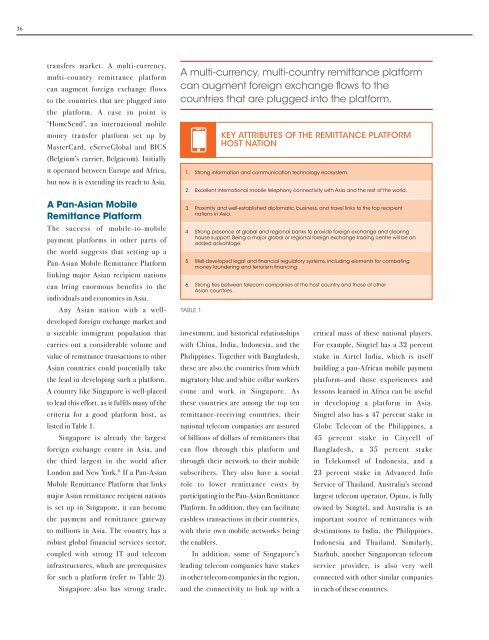SMU_AMI_November_Spread
You also want an ePaper? Increase the reach of your titles
YUMPU automatically turns print PDFs into web optimized ePapers that Google loves.
36<br />
transfers market. A multi-currency,<br />
multi-country remittance platform<br />
can augment foreign exchange flows<br />
to the countries that are plugged into<br />
the platform. A case in point is<br />
‘HomeSend’, an international mobile<br />
money transfer platform set up by<br />
MasterCard, eServeGlobal and BICS<br />
(Belgium’s carrier, Belgacom). Initially<br />
it operated between Europe and Africa,<br />
but now it is extending its reach to Asia.<br />
A Pan-Asian Mobile<br />
Remittance Platform<br />
The success of mobile-to-mobile<br />
payment platforms in other parts of<br />
the world suggests that setting up a<br />
Pan-Asian Mobile Remittance Platform<br />
linking major Asian recipient nations<br />
can bring enormous benefits to the<br />
individuals and economies in Asia.<br />
Any Asian nation with a welldeveloped<br />
foreign exchange market and<br />
a sizeable immigrant population that<br />
carries out a considerable volume and<br />
value of remittance transactions to other<br />
Asian countries could potentially take<br />
the lead in developing such a platform.<br />
A country like Singapore is well-placed<br />
to lead this effort, as it fulfils many of the<br />
criteria for a good platform host, as<br />
listed in Table 1.<br />
Singapore is already the largest<br />
foreign exchange centre in Asia, and<br />
the third largest in the world after<br />
London and New York. 8 If a Pan-Asian<br />
Mobile Remittance Platform that links<br />
major Asian remittance recipient nations<br />
is set up in Singapore, it can become<br />
the payment and remittance gateway<br />
to millions in Asia. The country has a<br />
robust global financial services sector,<br />
coupled with strong IT and telecom<br />
infrastructures, which are prerequisites<br />
for such a platform (refer to Table 2).<br />
Singapore also has strong trade,<br />
A multi-currency, multi-country remittance platform<br />
can augment foreign exchange flows to the<br />
countries that are plugged into the platform.<br />
KEY ATTRIBUTES OF THE REMITTANCE PLATFORM<br />
HOST NATION<br />
1. Strong information and communication technology ecosystem.<br />
2. Excellent international mobile telephony connectivity with Asia and the rest of the world.<br />
3. Proximity and well-established diplomatic, business, and travel links to the top recipient<br />
nations in Asia.<br />
4. Strong presence of global and regional banks to provide foreign exchange and clearing<br />
house support. Being a major global or regional foreign exchange trading centre will be an<br />
added advantage.<br />
5. Well-developed legal and financial regulatory systems, including elements for combating<br />
money laundering and terrorism financing.<br />
6. Strong ties between telecom companies of the host country and those of other<br />
Asian countries.<br />
Table 1<br />
investment, and historical relationships<br />
with China, India, Indonesia, and the<br />
Philippines. Together with Bangladesh,<br />
these are also the countries from which<br />
migratory blue and white collar workers<br />
come and work in Singapore. As<br />
these countries are among the top ten<br />
remittance-receiving countries, their<br />
national telecom companies are assured<br />
of billions of dollars of remittances that<br />
can flow through this platform and<br />
through their network to their mobile<br />
subscribers. They also have a social<br />
role to lower remittance costs by<br />
participating in the Pan-Asian Remittance<br />
Platform. In addition, they can facilitate<br />
cashless transactions in their countries,<br />
with their own mobile networks being<br />
the enablers.<br />
In addition, some of Singapore’s<br />
leading telecom companies have stakes<br />
in other telecom companies in the region,<br />
and the connectivity to link up with a<br />
critical mass of these national players.<br />
For example, Singtel has a 32 percent<br />
stake in Airtel India, which is itself<br />
building a pan-African mobile payment<br />
platform–and those experiences and<br />
lessons learned in Africa can be useful<br />
in developing a platform in Asia.<br />
Singtel also has a 47 percent stake in<br />
Globe Telecom of the Philippines, a<br />
45 percent stake in Citycell of<br />
Bangladesh, a 35 percent stake<br />
in Telekomsel of Indonesia, and a<br />
23 percent stake in Advanced Info<br />
Service of Thailand. Australia’s second<br />
largest telecom operator, Optus, is fully<br />
owned by Singtel, and Australia is an<br />
important source of remittances with<br />
destinations to India, the Philippines,<br />
Indonesia and Thailand. Similarly,<br />
Starhub, another Singaporean telecom<br />
service provider, is also very well<br />
connected with other similar companies<br />
in each of these countries.


